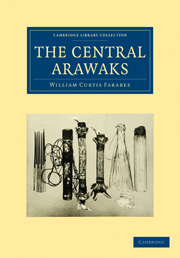Summary
HISTORY.
The first mention we find of the Tarumas is in the year 1668, when Pedro da Costa Favella and Father Theodosio of the order of mercy, the first navigators of Rio Negro, entered into communication with them on the lower Negro River. The Tarumas assisted them in building the first town on that river, Fortalezza da Barra, the site of the present city of Manaos.
Von Martius, in his enumeration of the Indian tribes, published in 1867, considers the Tarumas extinct. The first report of them on the Essiquibo was given by a Carib chief who visited Demarara about 1800. He gave a very fabulous account of them, saying that they were amphibious, living in caverns under the water, whither they were in the habit of fleeing upon the approach of strangers.
The Tarumas have a tradition that they came from the south and that their ancestors were tall heavy men. Another branch of the tribe, the Parauien, recently became extinct.
Their material culture is very much the same as that of the Wapisianas. As they live in the forested area and not in the open savannahs, their houses differ somewhat from the usual type of the Wapisiana's. The framework is the same, but they use no side walls of mortar. The thatch continues to the ground either with or without a wall. A man and his wife tie their hammocks to the same two posts and the man sleeps above.
- Type
- Chapter
- Information
- The Central Arawaks , pp. 135 - 158Publisher: Cambridge University PressPrint publication year: 2009First published in: 1918



